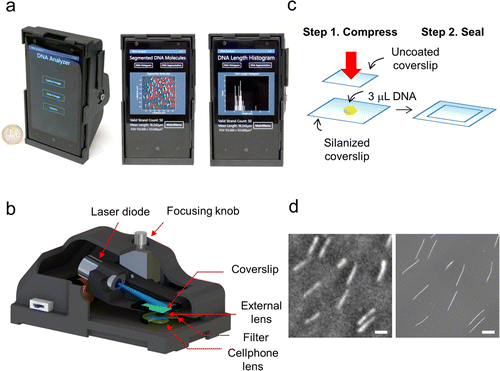Smartphone Becomes DNA diagnostic tool
May 04, 2015
on
on

A team of researchers at the University of California, Los Angeles have designed a relatively low-cost smartphone add-on device that turns it into a mobile DNA imaging tool. Techniques using optical microscopy have found numerous applications in biology, chemistry and physics but they require relatively expensive, bulky and complicated instruments that cannot be easily transported outside the lab environment
The team have developed a compact, lightweight and cost-effective fluorescence microscope which clips onto a mobile phone and makes use of its built-in camera. Using the device they have demonstrated imaging and length quantification of single molecule DNA strands.
In addition to the optomechanical attachment that creates a high contrast dark-field imaging setup using an external lens, thin-film interference filters, a miniature dovetail stage and a laser-diode for oblique-angle excitation, they have also created a computational framework and a mobile phone app connected to a server back-end for measurement of the lengths of individual DNA molecules that are labeled and stretched using disposable chips. Using this mobile phone platform, they imaged single DNA molecules of various lengths to demonstrate a sizing accuracy of <1 kilobase-pairs (kbp) for 10 kbp and longer DNA samples imaged over a field-of-view of ∼2 mm2.
The team anticipate that this level of length measurement accuracy and throughput are sufficient for probing gene-level structure information from single DNA molecules, and therefore this platform can serve as the stepping stone for next-generation mobile biomedical analysis, sensing and diagnostic tools and may be useful for field and POC measurements of copy numbers variations in human genome, early detection of cancers, nervous system disorders or drug resistance in infectious diseases such as malaria
The team have developed a compact, lightweight and cost-effective fluorescence microscope which clips onto a mobile phone and makes use of its built-in camera. Using the device they have demonstrated imaging and length quantification of single molecule DNA strands.
In addition to the optomechanical attachment that creates a high contrast dark-field imaging setup using an external lens, thin-film interference filters, a miniature dovetail stage and a laser-diode for oblique-angle excitation, they have also created a computational framework and a mobile phone app connected to a server back-end for measurement of the lengths of individual DNA molecules that are labeled and stretched using disposable chips. Using this mobile phone platform, they imaged single DNA molecules of various lengths to demonstrate a sizing accuracy of <1 kilobase-pairs (kbp) for 10 kbp and longer DNA samples imaged over a field-of-view of ∼2 mm2.
The team anticipate that this level of length measurement accuracy and throughput are sufficient for probing gene-level structure information from single DNA molecules, and therefore this platform can serve as the stepping stone for next-generation mobile biomedical analysis, sensing and diagnostic tools and may be useful for field and POC measurements of copy numbers variations in human genome, early detection of cancers, nervous system disorders or drug resistance in infectious diseases such as malaria
Read full article
Hide full article

